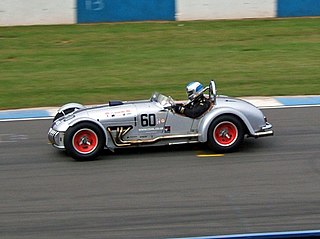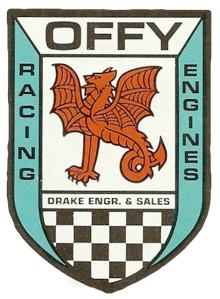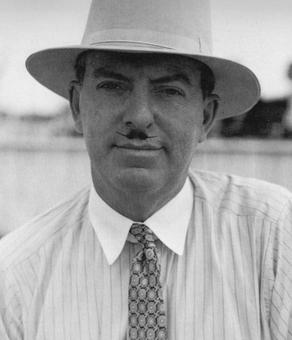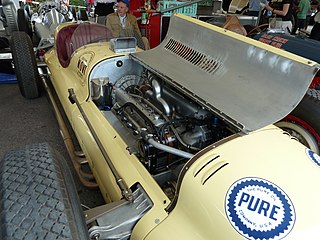
The Indianapolis 500, formally known as the Indianapolis 500-Mile Race, and commonly shortened to Indy 500, is an annual automobile race held at the Indianapolis Motor Speedway in Speedway, Indiana, United States, an enclave suburb of Indianapolis. The event is traditionally held over Memorial Day weekend, usually the last weekend of May. It is contested as part of the IndyCar Series, the top level of American open-wheel car racing, a formula colloquially known as "Indy car racing". The track itself is nicknamed the "Brickyard", as the racing surface was first paved in brick in the fall of 1909. One yard of brick remains exposed at the start/finish line. The event, billed as The Greatest Spectacle in Racing, is considered part of the Triple Crown of Motorsport along with the 24 Hours of Le Mans and the Monaco Grand Prix, with which it typically shares a date.

Rodger Morris Ward was an American racing driver best known for his open-wheel career. He is generally regarded as one of the finest drivers of his generation, and is best known for winning two National Championships, and two Indianapolis 500s, both in 1959 and 1962. He also won the AAA National Stock Car Championship in 1951.
Frank Peter Kurtis was an American racing car designer. He designed and built midget cars, quarter-midgets, sports cars, sprint cars, Indy cars, and Formula One cars. He was the founder of Kurtis Kraft.

The 1950 Formula One season was the fourth season of the FIA Formula One motor racing. It featured the inaugural FIA World Championship of Drivers, which was contested over seven races between 13 May and 3 September 1950. The only one outside of Europe was the Indianapolis 500, which was run to AAA National Championship regulations. No Formula One drivers competed in the Indy 500 or vice versa. Finally, the season also included several non-championship races for Formula One cars.
Eddie Johnson was an American race car driver.

Kurtis Kraft was an American designer and builder of race cars. The company built midget cars, quartermidgets, sports cars, sprint cars, Bonneville cars, and USAC Championship cars. It was founded by Frank Kurtis when he built his own midget car chassis in the late 1930s.

The Offenhauser Racing Engine, or Offy, is a racing engine design that dominated American open wheel racing for more than 50 years and is still popular among vintage sprint and midget car racers.
Cecil Green was an American racecar driver from Dallas, Texas.

Maurice Rose was an American racing driver. He won the Indianapolis 500 in 1941, 1947, and 1948, becoming the race's third three-time winner. He also won the AAA National Championship in 1936.
William Lawrence Schindler was an American racing driver.

Emil Albert Diedt was an American race car builder. He specialized in body-building and metalwork, and his chassis won the Indianapolis 500 in 1947 and 1948 with Mauri Rose, and in 1949 with Bill Holland. Diedt's cars ran with Offenhauser engines, and the three victories were the only major American open-wheel racing (AAA) wins for him.

Harold Arminius Miller, commonly called Harry, was an American race car designer and builder who was most active in the 1920s and 1930s. Griffith Borgeson called him "the greatest creative figure in the history of the American racing car". Cars built by Miller won the Indianapolis 500 nine times, and other cars using his engines won three more. Millers accounted for 83% of the Indy 500 fields between 1923 and 1928.
Fred H. Offenhauser, Jr., was a machinist and self taught automotive engineer who developed the Offenhauser racing engine, nicknamed the "Offy", which dominated competition in the Indianapolis 500 race for decades. He also built the Novi engine, which was designed by Bud Winfield and Leo Goossen.

Louis Meyer was an American racing driver who was the first three-time winner of the Indianapolis 500. He is generally regarded as one of the finest racers of his generation. Meyer is perhaps best known as the driver who started the tradition of drinking milk after winning the Indianapolis 500.
Joseph Paul Leonard was an American professional motorcycle racer and racecar driver.

The Novi engine is an American dual overhead cam supercharged V8 engine used in racing cars in the Indianapolis 500 from 1941 to 1966. Designed by Bud Winfield and Leo Goossen, it was built by Fred Offenhauser.

Harry Henry Hartz was an American racing driver and auto mechanic.
The 1981 CART PPG Indy Car World Series season, the third in the CART era of U.S. open-wheel racing, consisted of 11 races, beginning in Avondale, Arizona on March 22 and concluding at the same location on October 31. The PPG Indy Car World Series Drivers' Champion was Rick Mears despite missing Round 2 at Milwaukee due to injuries sustained in the Indianapolis 500. Rookie of the Year was Bob Lazier. After the disagreement with the USAC during the previous season, the 65th Indianapolis 500 was not part of the Series, however no competing race was scheduled and most CART teams and drivers did take part.
Leo William Goossen was a draftsman, mechanical engineer and automobile designer. He is known for his work with Harry Miller and his long involvement in the design and ongoing development of the four-cylinder Offenhauser ("Offy") racing engine.

The McLaren M16 was a race car designed and built by McLaren between 1971 and 1976 for American open wheel racing. It is the most successful car of the 1970s at the Indianapolis 500 with three wins in 1972, 1974 and 1976 and the last one to win with the Offenhauser engine.













